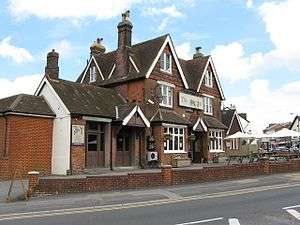Caterham Arms pub bombing
On 27 August 1975 a Provisional IRA bomb exploded without warning at the Caterham Arms public house in Caterham, Surrey, England. There were no fatalities but 33 people were injured, some severely. Two off-duty soldiers lost their legs as a result of the bombing.
| Caterham Arms pub bombing | |
|---|---|
| Part of the Troubles | |
 The Caterham Arms in 2009 | |
| Location | Caterham, Surrey, England |
| Date | 27 August 1975 21:20 (GMT) |
| Target | British soldiers and civilians |
Attack type | Time bombs |
| Deaths | 0 |
| Injured | 33 |
| Perpetrator | Provisional IRA's Balcombe Street Gang |
Background
In February 1975 the Provisional Irish Republican Army agreed to a truce and ceasefire with the British government and the Northern Ireland Office. Seven "incident centres" were established in Irish nationalist areas in Northern Ireland to monitor the ceasefire and the activity of the security forces.[1] Before the truce, the IRA active service unit (ASU) later dubbed the Balcombe Street Gang (due to the December 1975 Balcombe Street siege) had been carrying out bomb and gun attacks in Southern England since autumn 1974,[2] mostly in and around London. Their last previous attack was an assassination attempt on former Prime Minister Edward Heath but he was not home when the attackers threw a bomb into his bedroom window on 22 December 1974.[3]
The bombing
The Balcombe Street Gang planted a time bomb in the Caterham Arms public house in Caterham, Surrey. The IRA unit placed the 7lb bomb in a duffel bag under a seat. There was no warning and the bomb exploded at 9:20pm, injuring 23 civilians and 10 off-duty soldiers. The pub was used by members of the Welsh Guards who were based at the barracks nearby. Some of the injuries were very serious, with at least three soldiers losing limbs.[4][5] The blast blew the roof off the pub in the process. This attack marked the start of a renewed bombing campaign (Phase Two) in England and the end of the truce with the British Government.[6] The next day, the same IRA unit exploded a bomb in Oxford Street, injuring several people.[7]
Aftermath
One of the police officers in charge of the investigation into the bombing described it as a "carbon copy" of the Guildford pub bombings in October 1974 for which four people were already serving their sentences. The cell's campaign would continue until December 1975 when they were caught at the siege of Balcombe Street. The unit would eventually end up planting close to 50 bombs in London and elsewhere in southern England and carrying out several shootings which, along with the bombings, caused the deaths of nearly 20 people, injured hundreds and caused millions of pounds worth of damage to property.[8][9]
References
- Melaugh, Dr Martin. "CAIN: Chronology of the Conflict 1975". Cain.ulst.ac.uk. Retrieved 28 October 2018.
- Melaugh, Dr Martin. "CAIN: Chronology of the Conflict 1974". Cain.ulst.ac.uk. Retrieved 28 October 2018.
- Melaugh, Dr Martin. "CAIN: Chronology of the Conflict 1974". Cain.ulst.ac.uk. Retrieved 28 October 2018.
- "Hansard, Written Answers, 2 November 1976".
- "The Road to Balcombe Street: The IRA Reign of Terror in London".
- "CAIN: PRONI Public Records on CAIN Web". ulst.ac.uk.
- "CAIN: PRONI Public Records on CAIN Web". ulst.ac.uk.
- Melaugh, Dr Martin. "CAIN: Chronology of the Conflict 1975". Cain.ulst.ac.uk. Retrieved 28 October 2018.
- Melaugh, Dr Martin. "CAIN: Chronology of the Conflict 1975". Cain.ulst.ac.uk. Retrieved 28 October 2018.